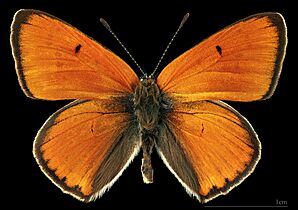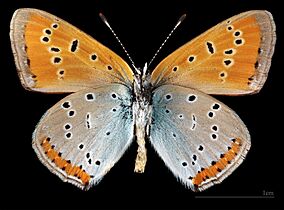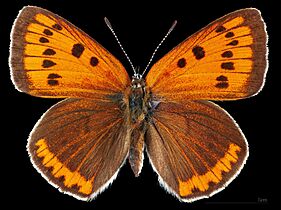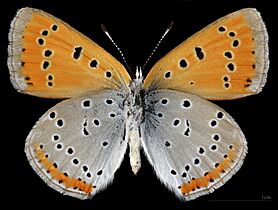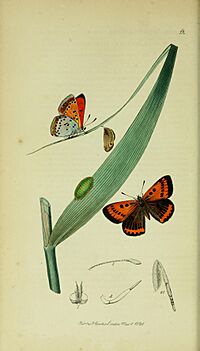Large copper facts for kids
Quick facts for kids Large copper |
|
|---|---|
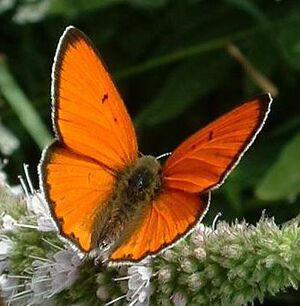 |
|
| Male | |
| Conservation status | |
| Scientific classification | |
| Synonyms | |
|
The large copper (Lycaena dispar) is a beautiful butterfly from the Lycaenidae family. It's known for its bright orange-copper wings. There are three main types, or subspecies, of this butterfly.
One type, L. dispar dispar, used to live in England but is now extinct. Another type, L. d. batavus, lives in the Netherlands and has been brought back to the United Kingdom. The third type, L. d. rutilus, is common across central and southern Europe. Sadly, the number of L. d. rutilus butterflies is going down in many European countries because they are losing their homes.
Contents
About the Large Copper
The large copper butterfly can be different sizes. Males often have an extra black spot on their upper wings. Females usually have a much larger spot. Sometimes, these spots can be very big, looking like a streak. Some butterflies can even be very pale, with light patches on their wings.
The rutilus type, found in Europe, usually doesn't have the extra spot on its front wing. Its spots on the underside are also smaller. The butterflies that hatch in spring can look a bit different from those that hatch in summer.
Where They Live
The large copper butterfly is found in many countries. These include Armenia, Austria, Azerbaijan, Belarus, Belgium, Bulgaria, Czech Republic, Estonia, Finland, France, Georgia, Germany, Greece, Hungary, Italy, Kazakhstan, Latvia, Lithuania, Luxembourg, Moldova, Mongolia, Montenegro, Poland, Switzerland, Turkey, Ukraine, and Uzbekistan.
It is no longer found in the United Kingdom. This is because it lost its natural habitat. The butterfly became extinct in the British Isles in the 1860s. Its numbers are also dropping in many other western European countries.
Types of Large Copper Butterflies
Here are the different types, or subspecies, of the large copper butterfly:
- †L. d. dispar (Haworth, 1802) − Found in England, now extinct.
- L. d. batavus (Oberthür, 1923) – Found in the Netherlands.
- L. d. rutila (Werneberg, 1864) − Found across Europe, Caucasus, and parts of Asia.
- L. d. festiva Krulikowsky, 1909 − Found in the Ural mountains and western Siberia.
- L. d. dahurica (Graeser, 1888) − Found in Transbaikalia and western Amur.
- L. d. aurata Leech, 1887 − Found in Siberia, eastern Amur, and Ussuri.
- L. d. borodowskyi Grum-Grshimailo, 1900 − Found in Manchuria.
History in England
The large copper butterfly was first seen in England in 1749. It lived in the marshy areas called fens in Huntingdonshire. Experts from the Entomological Society of London studied this butterfly.
The butterfly used to be common in England. Its eggs were laid on a plant called Rumex hydrolapathum. The caterpillars were green, like the leaves. The pupa, which is like a cocoon, was green at first, then grey.
In the early 1800s, many large coppers could be found in swampy areas like Whittlesea-Mere. But as more land was used for farming, these swamps were drained. This destroyed the butterfly's home. By 1847, only five butterflies were seen in Huntingdonshire. After that, no more were recorded.
Bringing Them Back
People tried to bring the large copper back to Britain in 1901. But it didn't work because there weren't enough of the right plants for the caterpillars to eat.
The first successful try was in 1913. A type of large copper from the Netherlands, L. d. batavus, was brought to a small bog in Ireland. This bog was made suitable by planting the butterflies' favorite food plants.
Distribution of the Large Copper
The large copper butterfly lives across central Europe. It can be found as far north as southern Finland. Its range extends across Asia to the Amur region and to Korea. In mainland Europe, it lives between 40° and 60° latitude.
Central Europe
In central Europe, the large copper often lives in drier places. These include unused fields and wet areas in cities.
Estonia
The large copper is a newer butterfly in Estonia. It was first seen there in 1947. In recent years, it has spread into the northwestern part of the country. In Estonia, the butterfly usually has one generation per year. It flies from late June to late July. Its main food plants there are R. crispus and R. obtusifolius. The large copper is now common in Estonia and can live in many different types of habitats.
Netherlands
In the Netherlands, large copper butterflies mostly eat one plant: R. hydrolapathum.
Germany and Austria
In Germany and Austria, these butterflies eat several different types of Rumex plants.
Habitat
The large copper butterfly lives in wetlands. These special habitats are shrinking across Europe. This is because land is drained for farming and other uses. The butterfly tries to use plants that grow away from the water's edge. This helps it avoid floods. It likes quiet grasslands along rivers and streams. This is where its food plant, the greater water dock (R. hydrolapathum), grows.
The butterflies prefer warmer places. This helps their caterpillars grow faster. Farming activities like mowing grass can harm the butterflies. If grass is mowed soon after eggs are laid, the eggs can be destroyed. The young caterpillars also lose their food plants. To help the large copper, its habitats need careful management. Making the habitat more varied can help many butterfly species.
Host Plants
The greater water dock (Rumex) is the main food plant for the large copper butterfly. In the eastern parts of its range, it uses many different Rumex species. In the western parts, it uses fewer. Female butterflies choose plants carefully for laying eggs. They look for plants that are the right height and size. They also prefer plants that get a lot of sunlight. This helps the larvae grow quickly.
Some good host plants include R. crispus (in southwest Germany and Austria) and R. obtusifolius (in Southwest France). R. hydrolapathum is the main food plant in Poland and North Germany. Other Rumex species used are R. conglomeratus, R. sanguineus, R. aquaticus, R. patientia, and R. stenophyllus.
Life Cycle
The large copper butterfly usually has two generations each year in Europe. The first generation flies from May to June. The second generation flies from late July to early September. The most butterflies are seen in July. The second generation produces more offspring. These young caterpillars spend the winter in a special resting state called diapause. This helps them survive cold weather and lack of food.
During winter, the caterpillars are in diapause. They can survive cold temperatures and hunger. But long floods can kill many caterpillars during this time.
The caterpillars go through three stages: before winter, during winter (diapause), and after winter. Many caterpillars die between when the eggs are laid in late summer and when they start feeding again in spring. Caterpillars begin feeding again in early May. They know when to start winter diapause based on temperature and daylight. They enter diapause when temperatures are low (below 15°C). They end diapause when temperatures are high (above 25°C).
Female Butterflies
Female large copper butterflies can lay many eggs, sometimes over 700 in their lifetime. They are very picky about where they lay their eggs. They prefer host plants that don't have flowers or fruits. Plants that get more sunlight help the caterpillars grow faster. So, females choose warmer spots for their eggs.
In late June, the caterpillars leave their food plant. They move to nearby plants, usually within 25 cm of their original plant and about 10 cm above the ground. There, they change color from bright green to pale yellow-brown. This helps them hide during pupation, which is when they turn into a chrysalis. This stage lasts about 10 to 14 days.
Predators
The large copper butterfly faces threats from other creatures. These include small animals without backbones, like insects, and also parasitoids (like Phryxe vulgaris). Many young caterpillars are eaten by these small animals before winter. Parasitoids often attack older caterpillars, causing them to die. Birds, amphibians, and small mammals also eat large copper butterflies.
Conservation Efforts
The large copper butterfly used to be a top priority for protection in the UK. It became extinct in Britain because its fen habitats were drained. In other parts of Western Europe, draining wetlands and building on riverbanks has caused a big decline. In Eastern Europe, it still lives along undeveloped riverbanks. But even there, human activity is starting to threaten it.
Several attempts have been made to bring the butterfly back to Britain and Ireland. But these have all failed. One reason is that butterflies raised in captivity for too long don't do well when released into the wild. They are not used to their natural environment. Researchers are now looking into trying again in larger habitats. These include the Great Fen project and the Norfolk Broads.
Today, the large copper is considered a "near threatened" species in some areas. This means there is growing concern for its future. It is protected by international agreements like the Bern Convention on the Conservation of European Wildlife and Natural Habitats. It is also listed in the European Community Habitats Directive. To help its numbers grow, more research is needed on how to raise them successfully. Conservation efforts must also deal with how sensitive the butterfly is to climate change and changes in land use. Draining wetlands and mowing grasslands too often harm the large copper population.
Images for kids



